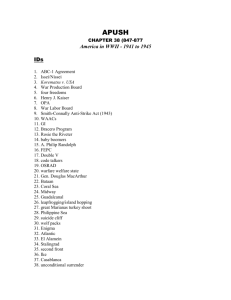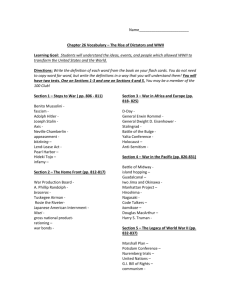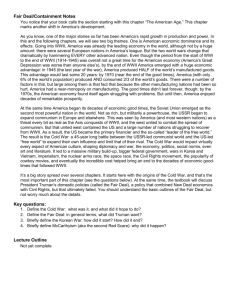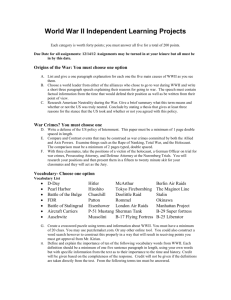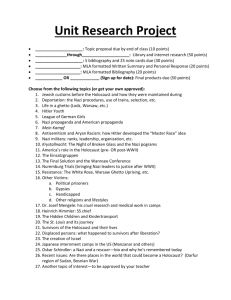Personal Responsibility lesson plan
advertisement
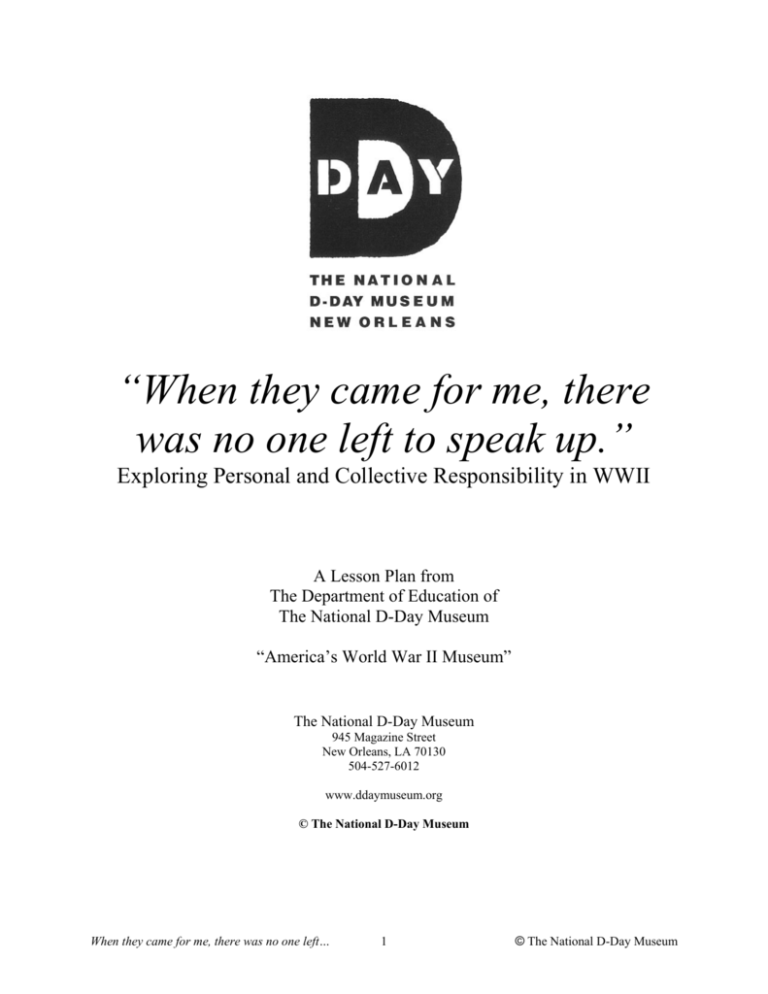
“When they came for me, there was no one left to speak up.” Exploring Personal and Collective Responsibility in WWII A Lesson Plan from The Department of Education of The National D-Day Museum “America’s World War II Museum” The National D-Day Museum 945 Magazine Street New Orleans, LA 70130 504-527-6012 www.ddaymuseum.org © The National D-Day Museum When they came for me, there was no one left… 1 © The National D-Day Museum “When they came for me, there was no one left to speak up.” Exploring Personal and Collective Responsibility in WWII “In Germany they came first for the Communists, and I didn't speak up because I wasn't a Communist. Then they came for the Jews, and I didn't speak up because I wasn't a Jew. Then they came for the trade unionists, and I didn't speak up because I wasn't a trade unionist. Then they came for the Catholics, and I didn't speak up because I was a Protestant. Then they came for me, and by that time no one was left to speak up.” --Pastor Martin Niemöller, 1945 OBJECTIVE: Students will explore the concepts of individual and collective responsibility for WWII atrocities by analyzing and critiquing Martin Niemöller’s famous statement. They will further explore and determine their own sense of responsibility for current local and world events. BENCHMARKS: Grades 5-8 C-1D-M2; C-1D-M3; H-1A-M1; H-1A-M2; H-1A-M3 Grades 9-12 C-1D-H2; H-1A-H2; H-1A-H6; H-1B-H13 DIRECTIONS: 1. Use this lesson plan while teaching your WWII unit or when teaching about civic and personal responsibility. 2. Share the attached information about WWII resistance movements throughout Europe with the class. Visit one of the suggested web sites for further exploration. 3. Read the biography of Niemöller to the class, or have a student read the biography, or photocopy the biography for each student to read. 4. Photocopy the student worksheet and distribute to students for individual or pairs completion. 5. Hold a class discussion allowing students to share their answers. 6. Complete the lesson by having students update Niemöller’s quote to reflect a current local, national, or world issue that they feel everyone should take responsibility for. Possible topics may include the environment, ethnic cleansing, civil liberties, school bullying, etc. Examples: “First they picked on the chess club members…”; “First they polluted the Great Lakes…”; “First they started racial profiling…”. Have students share their work. ASSESSMENT: Components for assessment include the student worksheet, the class discussion, and the creative writing exercise. ENRICHMENT: Have students research and write a report on one of the many resistance movements or resistance heroes active during WWII. Possible topics include the French Resistance, the Partisans in Yugoslavia, the “White Rose” student opposition movement, the Confessional Church in Germany, the Warsaw Ghetto uprising, Raoul Wallenberg, or Dietrich Bonhoeffer. When they came for me, there was no one left… 2 © The National D-Day Museum Resistance Movements, Partisans, and the “Righteous Among the Nations” During WWII the vast majority of people in Germany and the conquered countries of Europe played it safe. They were bystanders, trying to get on with their lives the best they could. They did not speak out against Nazi oppression or risk their well-being trying to defeat their new masters by aiding those in need. After the war, many claimed not to have known the true nature of Nazi persecutions and the Holocaust. Or they claimed they were just following orders. Or the law. Or the crowd. After all, they said, what can one person do? But at the same time brave people throughout Europe refused to give in to the Nazis. They fought with radio broadcasts and pamphlets, through spying and sabotage, and sometimes in face-to-face combat. They organized relief efforts for refugees, they rescued and protected downed Allied airmen, and they hid Jews from the Nazis. Some resistance movements were highly organized and numbered thousands of men and women. The French Resistance, the Partisans of Yugoslavia, the Jews of the Warsaw Ghetto uprising are examples of well-organized resistance movements. Inside Germany a group of students calling themselves the “White Rose” began secretly protesting Nazi policies of brutality. The “Red Orchestra” was an anti-Nazi group of German spies determined to end the Nazi regime in their country. Other resistance efforts were carried out by individuals committed to overcoming tyranny, oppression, and dictatorship, or merely helping a fellow human being who was in need. The four Dutch citizens who helped hide Anne Frank and her family in Amsterdam were such people. Raoul Wallenberg, a Swedish diplomat who stationed himself in Hungary, saved tens of thousands of Jews by issuing protective passes, establishing safe houses, and re-routing deportation trains bound for the death camps in Poland. He is one of 15,000 people recognized by Israel’s National Holocaust Memorial as “Righteous among the nations,” a non-Jew who risked his own safety to help save Jewish lives. People involved in these resistance movements and others risked torture and execution at the hands of the Nazis if caught. Many suffered that fate before the war ended. The WWII generation and every generation since have had to face the questions of who was guilty for the atrocities of WWII and debate the responsibilities of nations, of communities, and of individuals when facing oppression and persecution. Now read about the life of Martin Niemöller and his reflection on individual and collective responsibility. For more on WWII resistance, visit one or more of these web sites: U.S. Holocaust Memorial Museum http://www.ushmm.org/education/foreducators/resource/resistance.pdf A Teacher’s Guide to the Holocaust http://fcit.coedu.usf.edu/holocaust/timeline/RESIST2.htm Jewish Virtual Library: Holocaust Resistance http://www.us-israel.org/jsource/Holocaust/resisttoc.html When they came for me, there was no one left… 3 © The National D-Day Museum A Brief Biography of Martin Niemöller Martin Niemöller (pronounced Nee-mū-ler), born in 1892, served in the German navy as a Uboat commander during World War I. He was ordained as a Lutheran pastor in 1924 and showed early enthusiasm for Adolf Hitler’s ideas for the rebuilding of the German nation. But once Hitler came to power in 1933, Niemöller quickly became a critic of the Nazi leader’s militant and anti-Semitic actions and his attacks on the Protestant churches in Germany. Niemöller, along with other like-minded religious leaders—most famously Dietrich Bonhoeffer—formed a resistance movement called the Confessional Church. These leaders preached against Hitler and Nazism in the mid and late 1930s as WWII loomed. Hitler, seeking to silence any opposition, ordered the leaders of the Confessional Church arrested and sent to concentration camps. Niemöller was arrested in 1937 by Nazi authorities and sent first to Sachsenhausen and then to Dachau concentration camp. He stayed imprisoned until he was liberated by the Allies in the spring of 1945. Soon after the war, Niemöller helped compose the “Stuttgart Confession of Guilt,” acknowledging the German people’s collective guilt for the Holocaust. From 1961-1968 he served as President of the World Council of Churches. Throughout the rest of his life he preached reconciliation and disarmament. Martin Niemöller died in 1984. Niemöller’s Famous Quote “In Germany they came first for the Communists, and I didn't speak up because I wasn't a Communist. Then they came for the Jews, and I didn't speak up because I wasn't a Jew. Then they came for the trade unionists, and I didn't speak up because I wasn't a trade unionist. Then they came for the Catholics, and I didn't speak up because I was a Protestant. Then they came for me, and by that time no one was left to speak up.” --Martin Niemöller, 1945 Although Niemöller and other Germans actively preached and campaigned against Nazism in the 1930s, millions of others did nothing or actively supported Hitler as he consolidated his power and spread oppression and murder across Europe. Niemöller’s stirring quote was a statement aimed at all Germans for allowing such things to happen. His eloquent words soon became synonymous with the struggles of individual and national consciences everywhere, as the world came to recognize the enormous horrors of the Holocaust and the other atrocities of WWII. Today a debate about collective guilt during WWII still rages amongst academics and in the popular media. Were the German people as a whole guilty for the Holocaust, or just those actively supporting the Nazis? If someone does nothing to stop a crime, is he guilty of a crime himself? Can someone who commits war crimes or crimes against humanity be forgiven by claiming he was just following orders? Even today, Niemöller’s lines have meaning. They are often altered to fit differing political or social agendas, but they stand as a universal call for social action and solidarity and vigilance in the face of oppression and injustice. When they came for me, there was no one left… 4 © The National D-Day Museum “When they came for me, there was no one left to speak up.” Exploring Personal and Collective Responsibility in WWII Student Worksheet “In Germany they came first for the Communists, and I didn't speak up because I wasn't a Communist. Then they came for the Jews, and I didn't speak up because I wasn't a Jew. Then they came for the trade unionists, and I didn't speak up because I wasn't a trade unionist. Then they came for the Catholics, and I didn't speak up because I was a Protestant. Then they came for me, and by that time no one was left to speak up.” —Pastor Martin Niemöller, 1945 Directions: Read the above quote and answer the following questions on another sheet of paper using your own knowledge of WWII and your own opinions. Be prepared to share your answers. 1. Who are “they” that Niemöller writes about, as in, “first they came for…”? 2. What does it mean when he says, “came for”? 3. Why does he repeat the phrase, “Then they came for…” several times? 4. What effect does the repetition of this phrase have on the listener? 5. What other groups did the Nazis “come for” before and during WWII? 6. Who is the narrator of Niemöller’s quote supposed to be? 7. What does he mean by, “I didn’t speak up”? What are some ways he could have “spoken up”? 8. What do you think Niemöller’s purpose was for writing and speaking these lines throughout his life after the war? 9. Do you think that everyone in Germany was partly responsible for the Nazi’s rise to power, or that only those active in the Nazi Party were responsible? Explain your answer. 10. How much responsibility do you feel for what takes place around you: in your family, in your school, in your city, in your country, and in the world? List at least three responsibilities you feel for each level. When they came for me, there was no one left… 5 © The National D-Day Museum “When they came for me, there was no one left to speak up.” Exploring Personal and Collective Responsibility in WWII Updating Niemöller’s Quote Directions: now that you have read and thought about Martin Niemöller’s quote, it’s your turn to make a plea for personal and collective responsibility in our world today. Think about a societal issue you care about. It can be a local issue or a world-wide issue. Examples might be air or water pollution, racism, school bullying, or civil rights. Re-write the quote persuading your classmates to agree with your position. Be creative. You can stick with Niemöller’s structure, or use your own structure. Examples: “First they picked on the chess club members…”; “First they polluted the Great Lakes…”; “First they started racial profiling…” When they came for me, there was no one left… 6 © The National D-Day Museum
